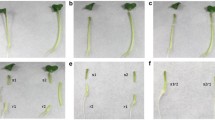Abstract
Rapid and systemic defence responses occur in various higher plants, including the tomato (Lycopersicon esculentum L.). The long-distance signalling mechanisms which permit these responses are not clear, but three models are currently considered in the literature: phloem transport, hydraulic dispersal in the xylem, and electrical transmission. Experiments presented here are designed to discriminate between these three models on the basis of some key predictions. It is demonstrated that wound signalling can be prevented by enclosure of the shoots in polythene bags, to generate high humidity. This effect can be reversed by addition of mannitol solution to the roots, showing that it depends on saturation of the plant's water status rather than on changes in the gaseous environment of the shoot. In addition, wound signals are shown to pass freely across heat-killed tissue. These results are predicted by the hydraulic-dispersal model of signalling, but they are not compatible with the other two models. We therefore conclude in favour of hydraulic dispersal.
Similar content being viewed by others
Abbreviations
- PI:
-
proteinase inhibitor
- PIIF:
-
proteinase-inhibitor-inducing factor
References
Alarcon, J.J., Malone, M. (1994) Substantial hydraulic signals are triggered by leaf-biting insects in tomato. J. Exp. Bot.45, 953–957
Boari, F., Malone, M. (1993) Wound-Induced hydraulic signals: survey of occurrence in a range of species. J. Exp. Bot.44, 741–746
Bradshaw, H.D., Hollick, J.B., Parsons, T.J., Clarke, H.R.G., Gordon, M.P. (1989) Wound-responsive genes in poplar encode proteins similar to sweet potato sporamins and legume kunitz trypsin inhibitors. Plant Mol. Biol.14, 51–59
Cordero, M.J., Raventos, D., San Segundo, B. (1994) Expression of a maize proteinas inhibitor gene is induced in response to wounding and fungal infection: systemic wound response of a monotoct gene. Plant J.6, 141–150
Broadway, R.M., Duffey, S.S., Pearce, G., Ryan, C.A. (1986) Plant proteinase inhibitors: a defence against herbivorous insects? Entomol. Exp. Applic.41, 33–38
Cunningham, D.D. (1895) The causes in the fluctuations in the motor organs of leaves. Ann. Bot. Gard. (Calcutta)6, 1–145
Graham, J.S., Hall, G., Pearce, G., Ryan, C.A. (1986) Regulation of synthesis of proteinase inhibitors I and II mRNAs in leaves of wounded tomato plants. Planta169, 399–405
Green, T.R., Ryan, C.A. (1973) Wound-induced proteinase inhibitor in tomato leaves. Plant Physiol.51, 19–21
Keil, M., Sanchez-Serrano, J.J., Willmitzer, L. (1989) Both wound-inducible and tuber-specific expression are mediated by the promoter of a single member of the proteinase inhibitor II gene family. EMBO J.8, 303–6
Malone, M. (1992) Kinetics of wound-induced hydraulic signals and variation potentials in wheat seedlings. Planta187, 505–510
Malone, M. (1993) Hydraulic signals. Phil. Trans. Roy. Soc. London Ser. B341, 33–39
Malone, M. (1994) Wound-induced hydraulic signals and stimulus transmission inMimosa. New Phytol.128, 49–56
Malone, M., Alarcon, J.-J., Palumbo, L. (1994a) A hydraulic interpretation of rapid long-distance wound signalling in the tomato. Planta193, 181–185
Malone, M., Palumbo, L., Boari, F., Monteleone, M., Jones, H.G. (1994b) The relationship between wound-induced hydraulic signals and proteinase inhibitors in tomato plants. Plant Cell Environ.17, 81–87
Malone, M., Stanković, B., (1991) Surface potentials and hydraulic signals in wheat leaves following localised wounding by heat. Plant Cell Environ.14, 431–436
Minchin, P.E.H., McNaughton, G.S. (1987) Xylem transport of recently fixed carbon within lupin. Aust. J. Plant Physiol.14, 325–9
Nelson, C.E., Walker-Simmonds M., Makus D., Zuroske G., Graham J., Ryan C.A. (1983) Regulation of synthesis and accumulation of proteinase inhibitors in leaves of wounded tomato plants. In: Plant resistance to insects, pp. 103–122, Hedin, P.A., ed. ACS, Washington
Nooden, L.D., Murray, B.J. (1982) Transmission of the monocarpic senescence signals via the xylem in soybean. Plant Physiol.69, 754–6
Orozco-Cardenas, M., McGurl, B., Ryan, C.A. (1993) Expression of an antisense prosystemin gene in tomato plants reduces resistance towardManduca sexta larvae. Proc. Nat. Acad. Sci. (USA)90, 8273–8276
Pearce, G., Johnson S., Ryan, C.A. (1993) Purification and characterisation from tobacco leaves of six small, wound-inducible, proteinase inhibitors of the potato inhibitor II family Plant Physiol.102, 639–44
Pearce, G., Strydon, D., Johnson, S., Ryan, C.A. (1991) A polypeptide from tomato leaves induces wound-inducible PI proteins. Science253, 895–8
Peña-Cortes, H., Sánchez-Serrano, J.J., Rocha-Sosa, M., Willmitzer, L. (1988) Systemic induction of proteinase-inhibitor-II gene expression in potato plants by wounding. Planta174, 84–89
Pickard, B.G. (1973) Action potentials in higher plants. Bot. Rev.39, 172–201
Ping, Z., Mimura, T., Tazawa, M. (1990) Jumping transmission of action potentials between separately placed internodal cells ofChara corallina. Plant Cell Physiol.31, 299–302
Ricca, U. (1916) Soluzione d'un problema di fisiologia. La propagazione di stimulo nellaMimosa. Nuov. Giorn. Bot. Ital.23, 51–170
Roblin, G. (1985) Analysis of the variation potential induced by wounding in plants. Plant cell Physiol.26, 455–461
Ryan, C.A. (1974) Assay and biochemical properties of the proteinase inhibitor-inducing factor, a wound hormone. Plant Physiol.54, 328–332
Ryan, C.A. (1977) The regulation by carbon dioxide of protein synthesis in tomato leaves. Biochem. Biophys. Res. Commun.77, 1004–8
Ryan, C.A. (1992) The search for the proteinase-inhibitor inducing factor, PIIF. Plant Mol. Biol.19, 123–133
Samejima, M., Sibaoka, T. (1983) Identification of the excitable cells in the petiole ofMimosa pudica by intracellular injection of procion yellow. Plant Cell Physiol.24, 33–39
Tinz-Füchtmeier, A., Gradmann, D. (1990) Laser-interferometric re-examination of rapid conductance of excitation inMimosa pudica. J. Exp. Bot.41, 15–19
Van Sambeek, J.W., Pickard, B.G. (1976) Mediation of rapid metabolic, electrical, transpirational, and photosynthetic changes by factors released from wounds. Can. J. Bot.54, 2662–2671
Wildon, D.C., Thain, J.F., Minchin, P.E.H., Gubb, I.R., Reilly, A.J., Skipper, Y.D., Doherty, H.M., O'Donnel, P.J., Bowles, D.J. (1992) Electrical signalling and systemic proteinase inhibitor induction in the wounded plant. Nature360, 62–65
Author information
Authors and Affiliations
Additional information
This work was supported by the Agriculture and Food Research Council (UK). J.-J.A. is grateful for a Fellowship from the Ministerio de Education y Ciencia (Spain).
Rights and permissions
About this article
Cite this article
Malone, M., Alarcon, J.J. Only xylem-borne factors can account for systemic wound signalling in the tomato plant. Planta 196, 740–746 (1995). https://doi.org/10.1007/BF01106769
Received:
Accepted:
Issue Date:
DOI: https://doi.org/10.1007/BF01106769



